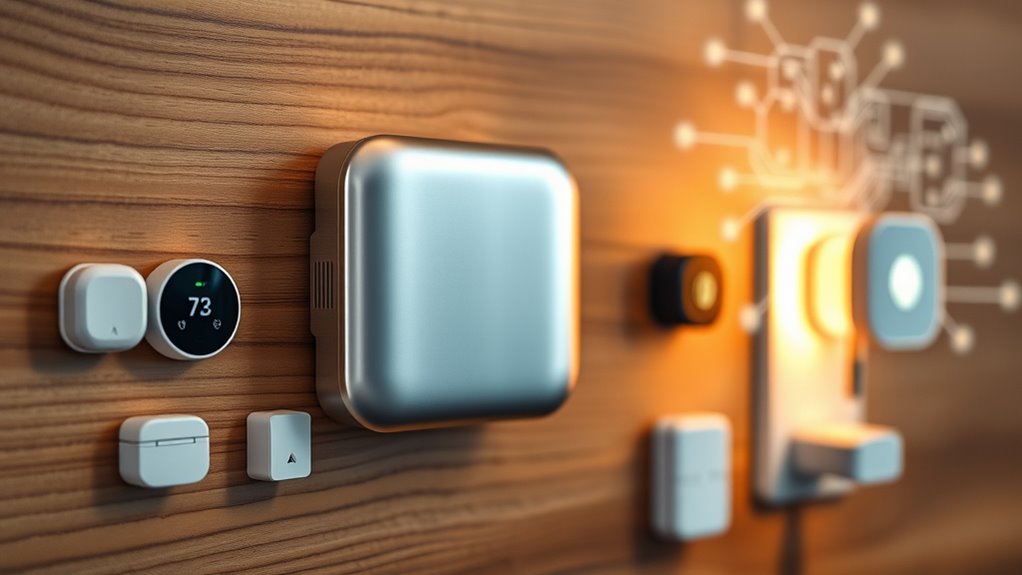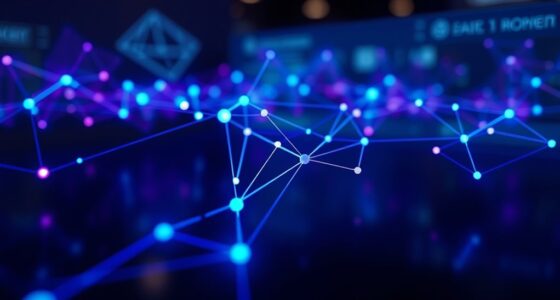Edge computing means processing data close to your IoT devices instead of sending everything to the cloud. It helps your devices respond faster, stay secure, and work smoothly even during internet outages. You’ll find it in smart homes, security systems, and autonomous cars, making them more efficient and private. If you want to discover how this technology makes everyday gadgets smarter and more reliable, keep exploring.
Key Takeaways
- Edge computing processes data locally on devices or nearby servers, reducing latency and bandwidth use for faster IoT responses.
- It enables smart devices like thermostats and security cameras to analyze data on-site, improving privacy and real-time decision-making.
- Edge devices handle tasks such as local data analysis, AI inference, and quick alerts without relying on cloud connections.
- This approach enhances device reliability, security, and functionality even during internet outages.
- Edge computing supports everyday IoT applications by making devices smarter, faster, and more secure through decentralized data processing.
What Is Edge Computing and Why Is It Important for IoT
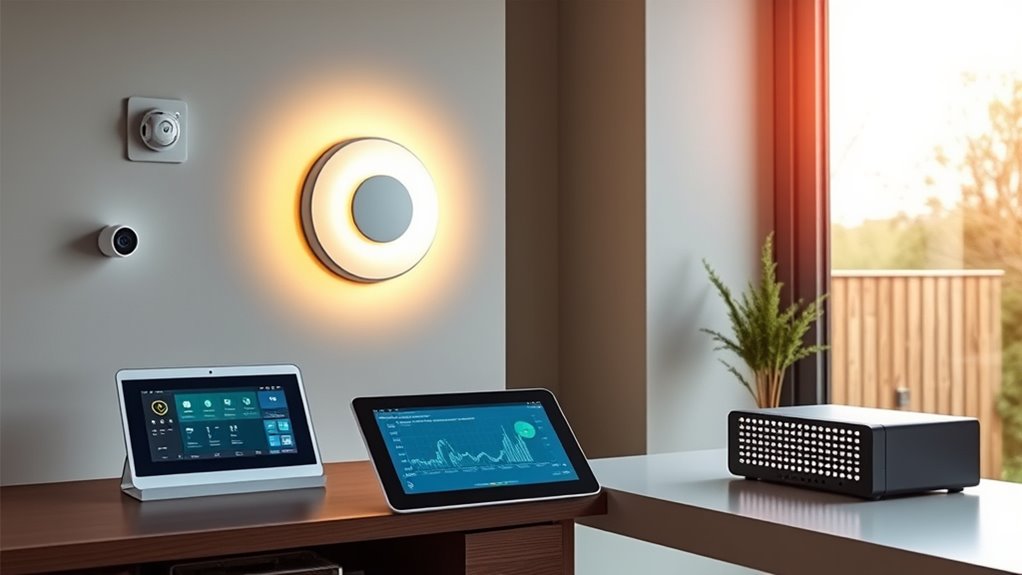
What exactly is edge computing, and why does it matter for IoT? Edge computing is a distributed framework that processes data close to where it’s generated, like IoT devices or local edge servers, instead of relying solely on distant cloud data centers. Its main goal is to reduce latency by handling computations locally, allowing devices to react quickly. This setup is essential for IoT because it generates vast amounts of data constantly. Processing that data at the edge means faster analysis, fewer delays, and less reliance on bandwidth-heavy transmissions to the cloud. It also helps IoT devices operate reliably when connectivity is limited or intermittent. Incorporating distributed computing principles further enhances the scalability and robustness of IoT systems by decentralizing processing tasks, which is especially important given the high data volumes generated by IoT devices. Additionally, advancements in edge device hardware are making local data processing more powerful and accessible for a wider range of applications. Moreover, understanding the benefits of edge computing helps in designing more efficient and resilient IoT solutions.
How Edge Devices Enhance Daily IoT Functionality

Edge devices play a crucial role in improving daily IoT functionality by enabling real-time data processing right at the source. This means you get immediate insights and faster responses without relying on distant servers. Here’s how they enhance your IoT experience:
Edge devices enable instant data processing at the source for faster, more secure IoT responses.
- Reduce latency by processing data locally, ensuring quick decision-making. Incorporating edge computing capabilities further enhances processing speed and efficiency. For example, tuning sensor calibration can significantly improve data accuracy and device responsiveness.
- Improve bandwidth efficiency by minimizing the need for constant cloud communication.
- Strengthen data security by keeping sensitive information within the device, lowering exposure risks. Implementing encryption techniques can further secure data during transmission and storage.
- Incorporating high-quality gelato flavors in smart vending machines can enhance user satisfaction and engagement. Additionally, tuning techniques in IoT devices can optimize their performance and reliability.
These benefits lead to more reliable, secure, and responsive systems. Whether managing smart homes, industrial automation, or environmental monitoring, edge devices help you operate more efficiently and confidently. They’re the backbone of seamless, real-time IoT functionality in everyday life.
Common Applications of Edge Computing in Everyday Life
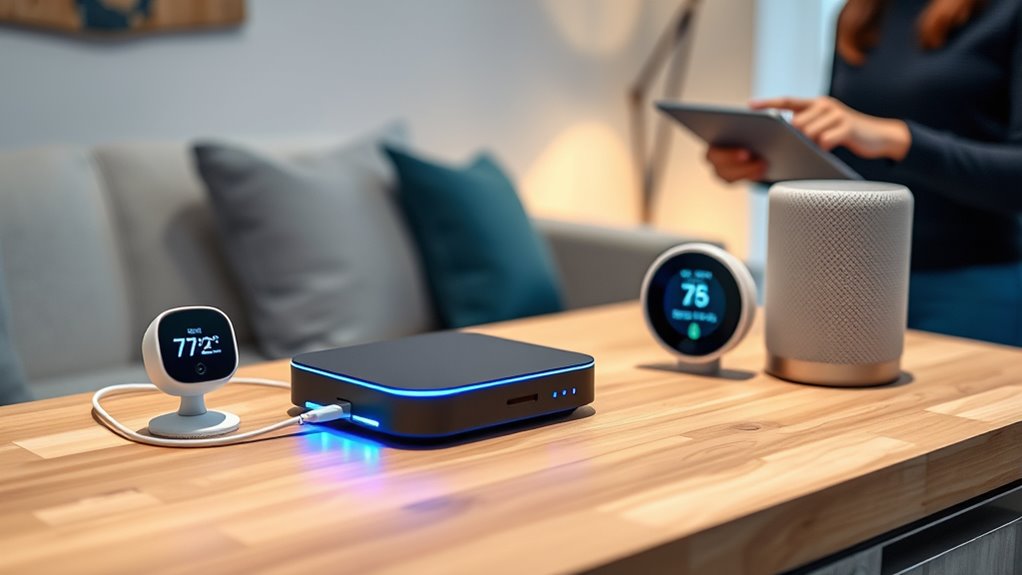
You encounter edge computing in many daily activities, from smart home automation to industrial equipment monitoring. It helps devices respond instantly and process data locally, reducing delays and reliance on cloud services. Understanding these applications shows how edge computing makes everyday life more efficient and connected. Additionally, asset division strategies are crucial during divorce proceedings to ensure a fair and cost-effective distribution of property. Many of these applications also benefit from glycolic acid products, which are designed to exfoliate and improve skin texture, demonstrating how targeted treatments enhance daily routines. Moreover, performance tuning techniques similar to those used in Porsche upgrades optimize device responsiveness and efficiency, just as local legal knowledge can improve case outcomes during legal proceedings. Recognizing the importance of legal residency requirements can also help in planning and implementing these technologies effectively in different regions.
Smart Home Automation
Have you ever wondered how your smart home responds instantly to your commands without lag? Edge computing makes this possible by processing data locally, ensuring quick reactions. Here are some key ways it benefits your smart home:
- Smart Thermostats: Learn your preferences and adjust temperature without cloud reliance. This local processing reduces reliance on external servers and improves response times.
- Security Systems: Analyze video footage locally for faster alerts and better privacy. Processing data on-device minimizes potential security breaches and delays.
- Lighting and Doorbells: Detect occupancy or motion instantly, adjusting lights or sending alerts without lag. This immediate response is crucial for home safety and convenience.
- Enhanced Privacy: By keeping data on-device, edge computing reduces the need to transmit sensitive information over the internet, protecting your privacy. Additionally, understanding edge computing can help optimize device performance and security.
This local processing minimizes latency, enhances device performance, and keeps your data secure. Even during internet outages, your devices keep functioning smoothly. Incorporating edge analytics into your devices can further improve their efficiency and responsiveness. Edge computing creates a seamless, responsive, and private smart home experience by making decisions right at the source.
Industrial Equipment Monitoring
Ever wondered how factories keep equipment running smoothly without constant human oversight? Edge computing makes this possible through industrial equipment monitoring. By continuously analyzing data from sensors, it detects issues early, reducing unexpected breakdowns and saving costs. This real-time analysis extends machinery lifespan by pinpointing problems before they worsen. Automated alerts prompt immediate maintenance actions, minimizing downtime. Sensors monitor parameters like temperature and vibration, allowing for instant adjustments that prevent failures. This proactive approach keeps production steady and efficient. Local data processing also supports informed decisions about maintenance schedules and resource use. Incorporating predictive analytics helps identify patterns that might predict future failures before they happen. Additionally, the integration of advanced algorithms enhances the accuracy of these predictions, further optimizing maintenance efforts. The use of edge devices ensures that data processing happens close to the equipment, reducing latency and improving response times. Edge computing also enables secure data handling by processing sensitive information locally, minimizing exposure risks. Overall, edge computing enables factories to operate smarter, safer, and more cost-effectively—keeping everything running smoothly with minimal delays and maximum productivity.
Autonomous Vehicle Sensors
Autonomous vehicle sensors rely heavily on edge computing to process vast amounts of data locally, guaranteeing quick and accurate decision-making on the road. This local processing reduces latency, supports faster obstacle detection, navigation, and traffic management, and handles massive sensor data streams without straining network bandwidth. Here’s how edge computing benefits you:
- Real-time Data Processing: Enables rapid decision-making, improving safety and responsiveness in complex environments.
- Sensor Data Management: Compresses and aggregates raw data, optimizing bandwidth and storage, and shares essential info with cloud systems when possible.
- V2X Communication: Facilitates low-latency, real-time exchanges between vehicles and infrastructure, enabling cooperative driving and traffic flow improvements.
- Importance of using low heat settings during maintenance or adjustments ensures the longevity and safety of sensitive components in autonomous systems.
This approach ensures safer, more efficient autonomous driving by minimizing delays and enhancing data handling capabilities.
Building Blocks of Edge Computing Architecture in IoT

To construct a resilient edge computing architecture, you need to focus on key components like edge nodes and gateways that handle data collection and aggregation. Local data storage guarantees you can process and analyze information instantly, even without cloud connectivity. Incorporating analytics and AI capabilities at the edge enables real-time insights and smarter decision-making directly where the data is generated.
Edge Nodes and Gateways
Have you ever wondered how IoT devices communicate and process data efficiently at the edge of a network? Edge nodes and gateways are key building blocks in this system. They perform critical functions like:
- Serving as local computing points that process data near the source to reduce latency.
- Filtering, aggregating, and analyzing data to lessen bandwidth use on cloud infrastructure.
- Connecting diverse sensors through multiple protocols, enabling local management and quick responses.
Edge nodes handle real-time analysis with moderate processing power, while gateways act as intermediaries that translate protocols and optimize data flow. Together, they support scalable, resilient, and secure IoT environments, balancing local intelligence with cloud integration for efficient operations.
Local Data Storage
Edge nodes and gateways process data locally to reduce latency and bandwidth use, but storing data nearby enhances these benefits further. By keeping data close—on-site servers or devices—you minimize transfer times and speed up processing. Local storage allows IoT devices to operate more efficiently, reducing reliance on constant cloud communication. It also lightens network load, saving costs and bandwidth. Plus, storing data at the edge boosts system resilience, maintaining functionality during connectivity issues. This storage can be embedded within devices or on nearby edge servers, supporting quick data retrieval and pre-processing. It’s essential for real-time applications like safety systems or environmental controls. Overall, local data storage helps guarantee faster, more secure, and reliable IoT operations, enabling immediate analytics and decision-making at the edge.
Analytics and AI Capabilities
How do IoT systems achieve rapid, accurate decision-making at the edge? They embed AI algorithms directly into devices, enabling instant data processing without relying on the cloud. This local intelligence supports milliseconds-level responses, vital for safety and efficiency in sectors like autonomous vehicles and industrial automation. Processing data at the source reduces latency compared to cloud-based methods, allowing quick anomaly detection and immediate responses such as maintenance alerts. Edge AI models facilitate fast operational adjustments, improving overall responsiveness.
- AI algorithms run directly on devices for immediate insights.
- Real-time analytics deliver quick, actionable data.
- Local inference ensures prompt anomaly detection and responses.
Challenges and Considerations for Implementing Edge Solutions
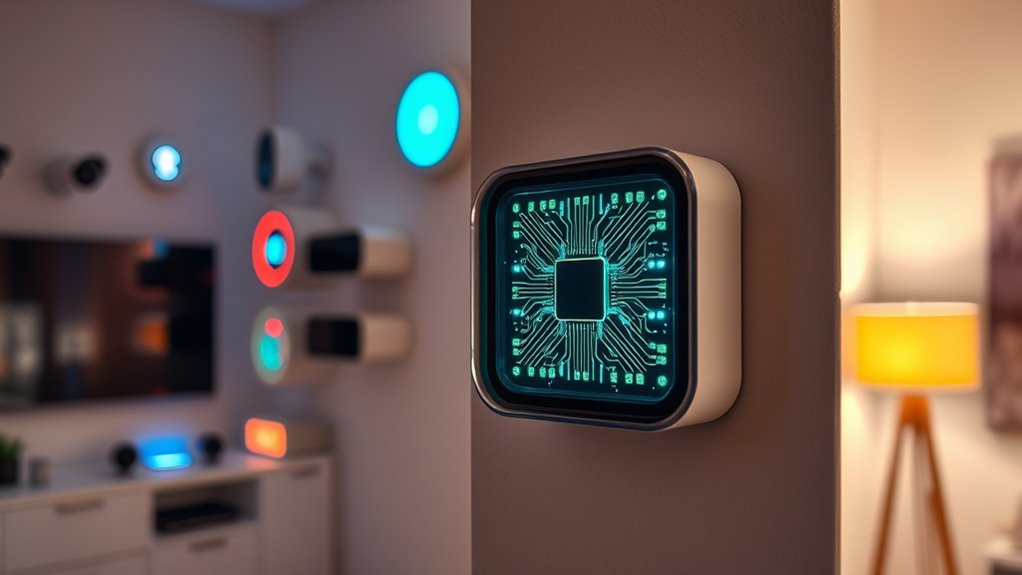
Implementing edge solutions presents several challenges that organizations must carefully navigate to guarantee success. You’ll face interoperability issues, as integrating diverse IoT devices with edge systems requires complex protocols. Managing these devices can be tough due to hardware and software differences, along with handling large data volumes efficiently. Scalability is another concern, as your system needs to grow with increasing devices and data. Security risks also multiply; the expanded attack surface and vulnerable devices demand robust protection, though limited resources on edge devices make this hard. Costs add up, from initial setup to ongoing maintenance and energy use. Additionally, ensuring real-time processing and low latency is crucial for time-sensitive applications. Finally, privacy and regulatory compliance must be addressed to build trust and protect sensitive data.
The Future of IoT and Edge Computing Integration
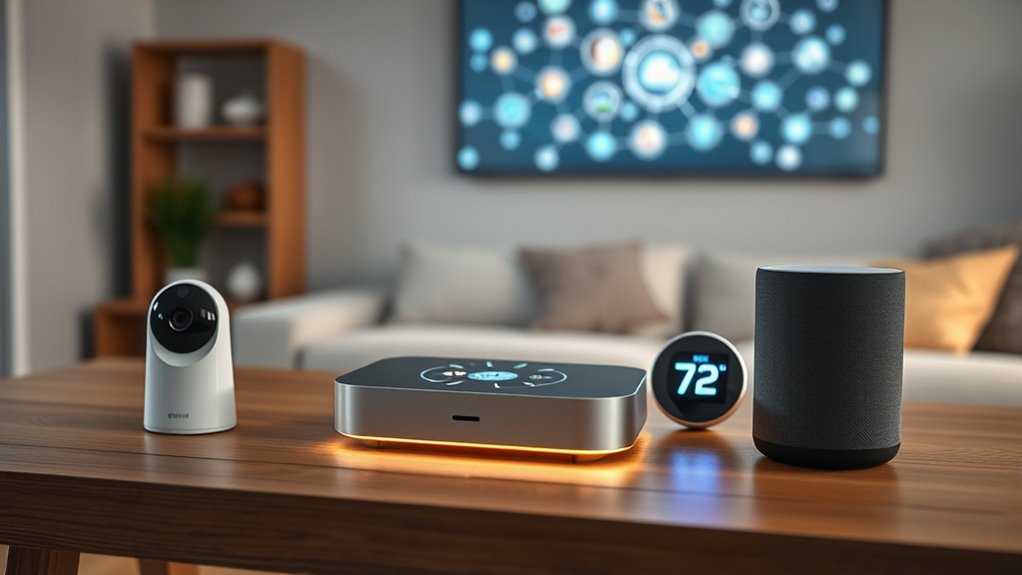
The integration of IoT and edge computing is rapidly evolving, driven by technological advancements and the demand for faster, more efficient data processing. Future trends focus on smarter, faster, and more secure systems. You’ll see:
The rapid evolution of IoT and edge computing drives smarter, faster, and more secure systems for enhanced efficiency and real-time insights.
- Increased use of AI and ML at the edge for real-time decision-making.
- 5G technology enabling ultra-low latency and massive device connectivity.
- Faster data processing by reducing reliance on central data centers.
These developments lead to improved security, operational efficiency, and support for real-time applications like autonomous vehicles and industrial automation. As hardware advances, edge devices become more capable, and centralized management platforms become essential. Connectivity options like 5G will enable widespread IoT deployment, transforming industries and smart infrastructure.
Frequently Asked Questions
How Do Edge Devices Manage Security Vulnerabilities Effectively?
To manage security vulnerabilities effectively, you should implement strong measures like multi-factor authentication and encryption to protect data. Regularly conduct security audits and keep software updated to fix known issues. Use network segmentation to limit attack spread and monitor devices continuously for suspicious activity. Hardening your devices with secure configurations and having a solid incident response plan in place guarantee you’re prepared to address vulnerabilities quickly and minimize risks.
What Standards Ensure Interoperability Between Diverse Iot and Edge Devices?
While the current question highlights the importance of seamless device communication, many standards guarantee interoperability between diverse IoT and edge devices. You’ll find the InterEdge specifications and OPAF standards especially helpful, as they promote physical and data compatibility. Additionally, OCF standards and IEEE guidelines foster smooth communication, while emerging standards like ISO/IEC AWI 30198 focus on edge computing gateways. Together, these frameworks help you build a flexible, integrated IoT ecosystem.
How Is Power Consumption Optimized in Remote Edge Computing Units?
You optimize power consumption in remote edge units by implementing low-power modes and sleep states that cut energy use during idle times. You also manage energy efficiently through battery and storage systems, and consider energy harvesting methods like solar. Dynamic voltage and frequency scaling adjusts processor power based on workload, ensuring devices only use what’s necessary. These strategies help extend device life, reduce costs, and improve overall energy efficiency.
Can Edge Computing Support Advanced AI Models on Iot Devices?
You might wonder if edge computing can handle advanced AI models on IoT devices. It definitely can. By bringing processing closer to data sources, it allows these devices to run complex AI algorithms locally, providing real-time insights. Lightweight models and hardware optimizations help overcome resource limits. This setup minimizes latency, boosts privacy, and keeps devices autonomous—even when internet access is spotty—making advanced AI practical at the edge.
What Strategies Facilitate Seamless Integration of Legacy Iot Systems With Edge Solutions?
To seamlessly integrate legacy IoT systems with edge solutions, you should use IoT gateways as communication bridges, translating protocols and filtering data to reduce network load. Implement APIs and standardized protocols like MQTT for compatibility, and retrofit sensors to keep hardware costs down. Combining edge computing with hybrid cloud strategies ensures efficient local processing while maintaining scalability, security, and ease of system expansion.
Conclusion
As you embrace edge computing, remember it’s not just about faster data processing but also about smarter, more responsive devices. While the technology simplifies your daily routines, it also demands careful planning and security. The future of IoT and edge computing promises seamless integration, yet challenges remain. Balancing innovation with caution guarantees you maximize benefits without sacrificing safety, making your connected world both smarter and more secure.
